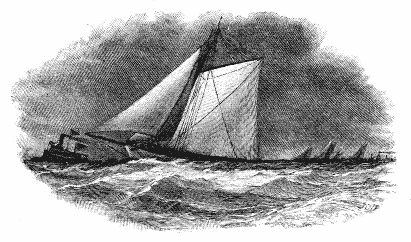When Men Were Men And Sails
Were Cotton
by Peter
H. Vanderwaart
The literary-minded
among you may have noticed the Walter Mitchell poem that appeared
in the Arts section of Duckworks a little while ago. My wife had
become aware of it while researching the author. It is far from
the only poem that Mitchell ever published. Another, "Rounding
the Stake Boat", was published in Harper's New Monthly Magazine.
I did not offer that one to Duckworks' publisher because I don't
think it's very good, but it triggered a little spot of historical
research of my own when lines from the poem called up a faint
memory of something I had once read.

"Rounding
The Stake Boat" describes a large racing yacht turning
the windward mark and setting off on the run. The ninth stanza
reads:
A
light hand leaps on the heel of the boom,
And
with swift knife slashes the reef knots free;
Drops
in the bunt as it yields him room,
While
it brushes the crest of the sending sea.
Or, prosaically,
a crew member runs out along the boom, cutting the reef points
so the mainsail can be raised to full area for the downwind leg.
The "bunt" is the loose fold of cloth that billows out
as the sail is freed from the reefing lines. The final line is:
the
"cup-defender" speeds up the bay.
Taken
together, I was reminded of a description I had once read of a
an exciting America's Cup race in New York Bay. After a fair amount
of looking, I found the following in an account by William P.
Stephens:
"Now,
as they ran off before the rising gale, I saw a man suspended
from a halyard and hauled by an outhaul along Vigilant's boom,
cutting the stops as he went."
At first,
it seemed possible that the poem had been written to commemorate
this famous race. There is a fatal flaw in the theory, however.
The poem was published in 1889, and the race between Valkyrie
and Viligent described by Stephens took place four years later
in 1893. Looking at the America's Cup races in the years preceeding
the poem's publication, I found that Cup racing had been plagued
by calm weather, and the only heavy weather race in the previous
several years had a run out with beat home, where the poem describes
the reverse.
Finally,
I noted that the poem's first stanza includes the line
The
fleet of fliers is left behind,
And
the white foam kisses her low lee rail.
The race
in the poem is not an America's Cup race at all, but a fleet race.
My entire theory that the poem commemorates a famous America's
Cup race was in tatters.
As I
thought the matter over, I decided that sending a hand out along
the boom to cut the reefing lines must have been the usual way
to shake out a reef. The sails were cotton, and delicate by today's
standards. Reefs were tied in using separate ties every few feet,
and booms were very long. Stephens cites several examples over
90 feet. The press of racing is not going to allow for untying
forty or fifty knots pulled tight by the force of a fresh wind
on a 10,000 sq ft mainsail.
I wonder what they did the second
time around.
***
It was usual to have men in the rigging
throughout the race, I believe. That would have given an interesting
perspective during whatever moments you weren't working too hard
to have a look around. Here are two complete paragraphs from the
Stephen's account from which the above sentence was excepted:
"While Valkyrie had started
with a half-reef, Vigilent turned in a full reef and set a working
topsail; after rounding she set her spinnaker in American fashion,
in stops, with sheet and tack slack and sail bellying forward;
then she set her balloon jib topsail. With the latter the halyard
jammed in the block and a man was sent down the stay to clear
things. Valkyrie, of course, followed the English practice of
setting her spinnaker flying; by ill luck the foot was slightly
torn in getting out the sail. The tear was extended until the
tear was in ribbons; it was taken in and her light-weather spinnaker
of fine linen was set, this fouling the bitts before it was up,
and blowing across the topmast stay, where it fouled a hook of
the jib topsail. As a last resort the "bowsprit spinnaker,"
the equivalent of our balloon jib topsail, was set."
"I had my glasses on the boats
from the time that the Committee tug reached the line. I had witnessed
some thrilling Cup and trial races, but none like this. Now, as
they ran off before the rising gale, I
saw a man suspended from a halyard and hauled by an outhaul along
Vigilant's boom, cutting the stops as he went. At the topmast
head was a second man, one at the end of the gaff, and a fourth
whom I could not see at the masthead. The head of the working
topsail was lashed and the halyard sent down, the clew of the
sail lashed to the gaff end and the sheet sent down, and when
all was ready the reef was shaken out, the whole mainsail spread,
and immediately the second club topsail was sent up to windward
of the working topsail. The fight for the last three miles was
an inspiring one, perhaps more so than the last half hour of the
final Genesta-Puritan race, Vigilant gaining foot by foot and
winning by a margin of 2 minutes 13 seconds actual time."
|

